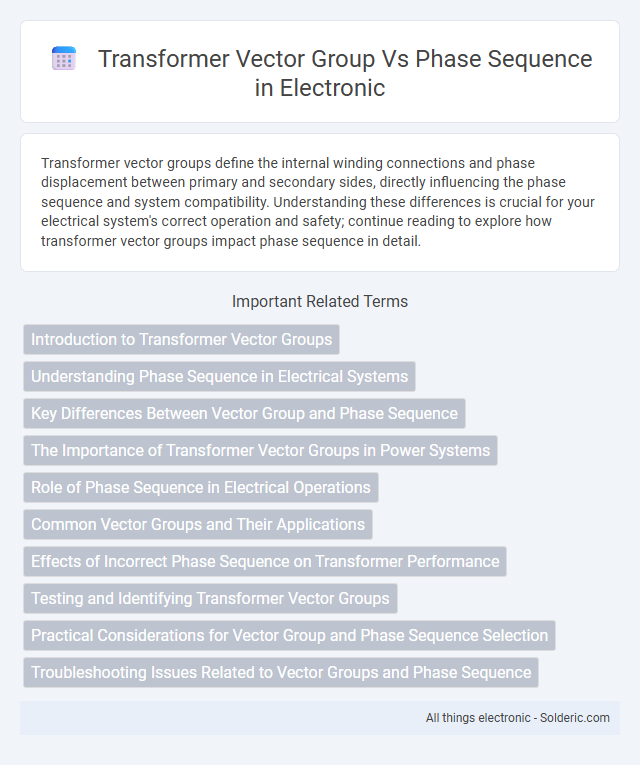Transformer vector groups define the internal winding connections and phase displacement between primary and secondary sides, directly influencing the phase sequence and system compatibility. Understanding these differences is crucial for your electrical system's correct operation and safety; continue reading to explore how transformer vector groups impact phase sequence in detail.
Comparison Table
| Feature | Transformer Vector Group | Phase Sequence |
|---|---|---|
| Definition | Standard notation indicating transformer winding connections and phase displacement. | Order of phases (A-B-C or A-C-B) in three-phase electrical systems. |
| Purpose | Specifies transformer winding configuration and phase shift between primary and secondary. | Determines direction of rotating magnetic field and phase rotation in power systems. |
| Notation | Commonly uses clock hour notation (e.g., Dyn11, Yd1). | Sequences named as positive sequence (ABC) or negative sequence (ACB). |
| Importance in System | Ensures correct transformer connection to avoid phase displacement issues. | Vital for motor rotation direction, load balancing, and fault analysis. |
| Application | Transformer design, protection coordination, and parallel transformer operation. | System protection, motor control, and power quality analysis. |
| Impact on Load | Controls voltage magnitude and phase angles between windings. | Affects motor rotation direction and symmetrical load distribution. |
Introduction to Transformer Vector Groups
Transformer vector groups define the angular relationship and phase displacement between primary and secondary windings, crucial for system compatibility and fault analysis. They use clock notation, such as Dyn11 or Yd1, to specify winding connections and corresponding phase shifts, ensuring correct synchronization with the power system. Understanding vector groups helps engineers design transformers that maintain proper load sharing and minimize circulating currents in parallel operations.
Understanding Phase Sequence in Electrical Systems
Phase sequence in electrical systems determines the order in which the three phases reach their peak voltages, directly impacting the operation of three-phase transformers and motors. Transformer vector groups indicate the winding connections and phase displacement, ensuring compatibility with the system's phase sequence to avoid reverse rotation or malfunction. You must verify the phase sequence alignment to ensure proper transformer performance and system stability.
Key Differences Between Vector Group and Phase Sequence
Transformer vector group defines the internal winding connection and phase displacement between primary and secondary windings, impacting voltage transformation and load balancing. Phase sequence refers to the order in which the phases reach their maximum voltage, essential for the correct operation of three-phase equipment. Understanding your transformer's vector group ensures compatibility with the system's phase sequence, preventing issues like circulating currents or mechanical stress.
The Importance of Transformer Vector Groups in Power Systems
Transformer vector groups define the phase difference and winding configuration, directly impacting system stability and fault protection coordination in power systems. Understanding your transformer's vector group ensures correct phase sequence alignment, reducing the risk of circulating currents and equipment damage. Accurate vector group selection improves load balancing and facilitates seamless integration with the grid, enhancing overall power quality and reliability.
Role of Phase Sequence in Electrical Operations
Phase sequence defines the order in which the three-phase voltages reach their peak values, directly impacting the direction of rotation in motors and the efficiency of transformers within a transformer vector group. Correct phase sequence ensures your electrical system operates safely and efficiently, preventing equipment damage and operational errors. Understanding phase sequence is crucial for designing and maintaining transformers that match the required vector group for optimal performance.
Common Vector Groups and Their Applications
Common transformer vector groups such as Dyn11, Yd11, and Yy0 indicate the phase displacement between the primary and secondary windings, critical for parallel operation and system stability. Dyn11 is often used in distribution transformers for its ability to handle unbalanced loads and facilitate grounding, while Yd11 suits industrial applications needing reliable phase shifting. Understanding your transformer's vector group ensures proper alignment with the power system's phase sequence, minimizing circulating currents and enhancing performance.
Effects of Incorrect Phase Sequence on Transformer Performance
Incorrect phase sequence in transformer connections causes reverse phase rotation, leading to circulating currents and increased losses. This results in overheating, reduced efficiency, and potential damage to winding insulation. Ensuring the correct vector group alignment maintains optimal transformer performance and prolongs the service life of your equipment.
Testing and Identifying Transformer Vector Groups
Testing and identifying transformer vector groups requires precise measurement of phase displacement and winding configurations using specialized instruments such as phase rotation meters and vector group testers. Accurate phase sequence verification ensures correct transformer operation and system compatibility by confirming the relative positions of primary and secondary windings. Your ability to analyze test results is crucial in detecting errors in vector group connections, preventing equipment damage and operational inefficiencies.
Practical Considerations for Vector Group and Phase Sequence Selection
Selecting the appropriate transformer vector group and phase sequence is crucial for ensuring compatibility with your existing electrical system and minimizing issues such as circulating currents or unbalanced voltages. Practical considerations involve matching the vector group to the load type and system configuration, accounting for phase displacement to avoid synchronization problems, and adhering to industry standards like IEC 60076. Understanding the impact of vector group on short-circuit current and load sharing enhances system reliability and efficiency.
Troubleshooting Issues Related to Vector Groups and Phase Sequence
Troubleshooting transformer vector group and phase sequence issues involves verifying correct wiring configurations and using phase angle measurement tools to detect mismatches that cause circulating currents or malfunction in parallel transformer operations. Incorrect vector group connections lead to improper load sharing and voltage unbalance, while wrong phase sequence results in reversed rotation of motors and relay malfunctions. Systematic testing with phase sequence indicators and insulation resistance measurements aids in identifying and correcting these faults efficiently.
transformer vector group vs phase sequence Infographic

 solderic.com
solderic.com